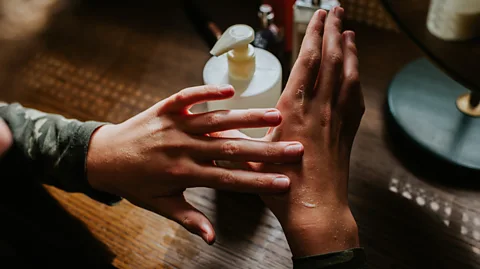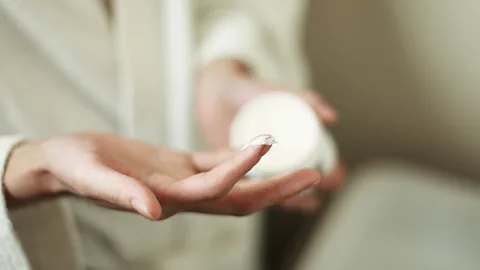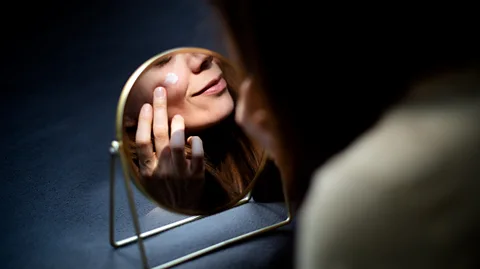Untraceable ingredients and unrecycled packaging: Why sustainable skincare is so hard to find
 Getty Images
Getty ImagesIn the baffling world of skincare ingredients, where is the best place to start seeking sustainable skincare?
Take a look at the ingredients list on the back of your moisturiser. First, count them. Then, ask yourself: do I know what they are? Mine, which is vegan and comes in a bottle made from 100% post-consumer recycled plastic, contains 26 listed ingredients, half of which I can't pronounce, let alone explain.
The longest among them is "acrylates/C10-30 alkyl acrylate crosspolymer". A quick internet search tells me this is a synthetic ingredient, commonly used in skincare as a thickening agent. But what is the environmental impact of this substance? Was it made using "green chemistry", which aims to reduce environmentally harmful chemicals and processes? Is it biodegradeable, or will it persist in waterways or landfill indefinitely?
Short of a chemistry degree, understanding how to make sustainable skincare choices is no easy task for most consumers.
Information on the environmental and social impact of beauty ingredients is scarce, despite the prevalence of cosmetic use. There is little recent data on how many products are typically used each day, but one survey of 2,300 people from 2004 estimated women use around 12 beauty products a day, and men six. Much like the fashion industry, much of the $430bn (£340bn) beauty industry lacks the transparency to enable consumers to make informed decisions.
You might also like:
"The beauty industry uses vast quantities of ingredients that are either grown, harvested and processed, or lab synthesised, but no numbers currently exist on the amount of ingredients used," says Lorraine Dallmeier, chief executive of skincare school Formula Botanica.
Dallmeier runs online courses for people to formulate their own botanical skincare products. At entry level is the creation of an eye cream, for which you would need a water bath (on a stove or hot plate); two beakers (in the course I watched, one was filled with jojoba oil, the other with rose water); a whisk, a set of scales, two glass rods, a thermometer and a pot of emulsifier. "Everyone can formulate," says Dallmeier.
I decide to give it a try, opting for the most basic product of all: a two-ingredient face oil, which doesn't include water. If a skincare product contains water or water-based ingredients – as lotions do – it needs a preservative to remain stable and safe to use. The "recipe" is given to me by Zurich-based skincare brand Soeder, which controls its entire supply chain from ingredients to packaging in its own factory and laboratory, and makes most of its products using cold-pressed oils and natural ingredients such as wheat and Swiss honey.
"The biggest problem with the beauty industry [when it comes to ingredients] is that brands often use pre-mixes in their products, which are pre-made combinations of technical raw materials," says Soeder co-founder Johan Åkerström. The constituent ingredients of these premixes do not have to be listed on the final product's label.
"For example, if a premix contains a surfactant like coco glucoside, it might have been made using palm oil. However, the palm oil won't be listed separately in the ingredients, making it unclear to consumers what went into the product," says Åkerström. (Read more about how palm oil plantations can harm nature and the climate.)
Only final ingredients, rather than the original source of those ingredients, are required by the International Nomenclature of Cosmetic Ingredients to be listed. The overall lack of clarity in labelling remains a challenge for consumers who want to know exactly what goes into the beauty products they use.
 Getty Images
Getty ImagesSoeder's recipe for a face oil is relatively simple: combine five drops of hemp seed oil with 15 drops of sweet almond oil. Apply twice a day, after cleansing and before moisturising. "Oils are tricky to use, so it's important to find an oil that suits your skin," Åkerström says. "Hemp is very light and high in omega fatty acids, so this is a well-balanced, generic recipe – and we use these ingredients in our soap. Massage onto the hands first, not directly onto the face."
But sourcing the ingredients was tricker. I found 100% (some oils are already mixed) cold-pressed sweet almond oil from a health store on my local high street, where a 100ml bottle cost £7 ($8.90). For pure hemp seed oil, I had to go online. A 500ml bottle was £8, plus £3 shipping ($10.20 plus $3.80 shipping). I found an own-brand equivalent face oil from a well-known high street store retailing at just £2.50 ($3.20), but a scan of the ingredients required the chemistry degree I don't have.
I calculate these supplies could last for over 100 applications. Plus, once made and applied, the oil smelled delicious and left my skin feeling soft and nourished.
"You are paying for the quality of the ingredients, which are nourishing, rather than cheap synthetic fillers," says Khandiz Joni, a former make-up artist turned sustainability consultant. "They're often more concentrated so you need less of it. And only buy what you need, finish what you have and choose refills, which are often cheaper."
When quality ingredients are more expensive, it's worth considering why alternatives might be cheaper. "It's like fast fashion," says Joni. "It takes physical energy, from the planet and the people making the products we use – we need to respect that. So find the most environmentally and socially responsible brands you can afford."
Joni advises seeking out brands that promote circularity, for example, by using waste ingredients, or using green chemistry in their formulation and manufacture, and who are transparent about their environmental impact from production, packaging and shipping. It's always worth carefully researching any company's environmental claims – read our guide on how to spot misleading green buzzwords.
 Getty Images
Getty ImagesThe Los-Angeles-based brand Ilia, which was founded by Sasha Plavsic in 2011 and acquired by Clarins in 2022, aims to pay particular attention to the sourcing of its ingredients. "Clarins grows many of their ingredients, so we work directly with their regulatory team on ensuring our products fall within the necessary regulatory requirements, which include visibility on all ingredients down to trace elements," says Plavsic. "Every ingredient can have issues in regards to sourcing – there is no perfect pathway."
Danka Tamburic, professor of cosmetic science at the London College of Fashion, argues that the effect of the manufacturing process of raw materials is often overlooked in determining how sustainable a cosmetic product is.
"Natural ingredients could theoretically be more sustainable, but in most cases the carbon footprint is actually higher than for synthetic ones," Tamburic says. "People forget that agriculture is very resource-demanding."
Tamburic has studied the energy use in manufacturing of emulsions, the most common cosmetic form, and found it to have a much greater effect on carbon emissions than the origin of the raw materials. Energy can be reduced by more than 80% by making emulsions using a method that requires less heat.
Tamburic adds that there’s often a misconception that "natural" equals "safe". "Safety and sustainability are two different things, yet the proposed common solution to both is the use of natural ingredients. This is simply not valid every time. Natural [ingredients] are neither inherently more sustainable, nor safer; each case has to be analysed on its own merit."
 Getty Images
Getty ImagesBesides the ingredients, what happens to the packaging once used is another major challenge for the industry.
Cosmetics packaging is often made of hard-to-recycle plastics, and more than 90% of cosmetics packaging goes to landfill. Every year, the global beauty industry contributes 100 billion units to the total plastic packaging consumption. The US, as a single market, is responsible for 11.4 billion of these units as of 2023, behind only China and India.
Some brands take part in take-back schemes where suppliers will accept packaging customers choose to return. Ilia, for example, works with non-profit Pact Collective to recycle its hard-to-recycle packaging. Customers can send up to 10 empty beauty products per month to Ilia – from its own range or another brand's – and Pact Collective says it will recycle it responsibly. Plavsic says that the partnership has diverted over 61,000 lbs (27.7 tonnes) of waste since launch.
The independent brand Meow Meow Tweet, also based in California, uses a closed-loop system that takes back empty bulk containers, sterilises and refills them, before selling again. Every month, Meow Meow Tweet chooses an organisation to support financially, prioritising small, mutual-aid, grassroots-focused groups, and those with queer or BIPOC (black, indigenous and people of colour) leadership.
"What excites me is when smaller companies break through the uniform, manufactured and antiquated concepts of beauty and provide products that understand real people and how they exist in the world and their own skin," says co-founder Tara Pelletier. "I think the beauty industry has a long way to go to get socially and environmentally responsible. The most significant thing that could be done to make an impact is to produce less, but that means selling less. And the industry isn't ready to shrink yet."
Dallmeier believes that pioneering challenger brands are changing the narrative around beauty, from telling people they're inadequate to focusing more on skin and mental health. "For decades, we've been told that we're not young enough, or attractive enough or smooth enough, that cellulite – a perfectly normal condition – is unsightly and can be cured, despite an evidence-based review concluding that anti-cellulite products don't work," she says. "And we know why they do this: to drive mass consumption."
Joni agrees and points to beauty influencers on social media showing their product-filled bathroom shelves. "How can they get through all those products? Think of the expiry dates!"
For Joni, much of the difficulty for consumers in making better choices lies in the use of the word "sustainable" to define a type of skincare. The comparatively higher price points of "sustainable" beauty products inadvertently position them as luxury. Yet, for anything to be truly sustainable, it needs to be equitable.
"We need to ask ourselves, what is sustainable skincare? In short, it's a way of thinking, and is as much down to the consumer as it is the brand. It's not simply how 'clean' or 'green' or 'eco' a product is; if you are not using it, it's not sustainable," says Joni. "It's about a complete mindset change."
I take the opportunity to ask Joni about my own moisturiser and the lengthy ingredient Acrylates/C10-30 Alkyl Acrylate Crosspolymer. "In short, it's a microplastic," she says.
Time to change it then, but not until I've used it all up first.
--
Correction: This article has been updated after incorrectly stating the subject of Danka Tamburic's study as emulsifiers, rather than emulsions. We apologise for the error.
--
If you liked this story, sign up for The Essential List newsletter – a handpicked selection of features, videos and can't-miss news delivered to your inbox every Friday.
